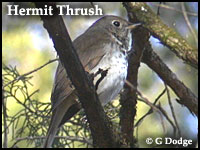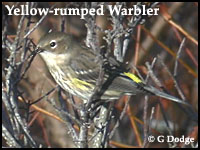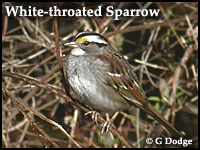Mallards are back in the Wetlands. Three Mutt Ducks (Mallard x Domestic) and eight or so “normal” Mallards have been feeding and resting in the quiet water and under the Willow Trees. Canada Geese are paying regular visits to the Wetlands.
For nearly a week after the passage of the cold front that moved through on the 18th/19th of October the skies were mostly clear with high cirrus clouds making it easy to pick out high flying birds. The 18th and 19th were busy bird days with lots of familiar avian visitors returning from the north. Warblers and other passerines rode in on the back of the front. The rest of the week was busy as well, mainly with high altitude hawks, but with a few other bird types as well. A flock of 13 Double-crested Cormorants in classic echelon formation flapped their way south on the 23rd of the month.
Turkey Vultures and Black Vultures sail over Explore the Wild and Catch the Wind daily, but on the 23rd they were truly soaring high. A group of 8 Turkey Vultures glided by at “little black speck” altitude with a few Black Vultures mixed in. Turkey Vultures (TVs) and Black Vultures (BVs) are fairly easy to separate (images at left). TVs have relatively long tails and soar with their wings held above the horizontal (dihedral). Additionally, TVs tend to teeter, or rock back and forth while soaring, giving them an unsteady appearance in flight. BVs have very short tails and although they sometimes hold their wings in a dihedral they are not consistent in doing so. They also tend to flap their wings rapidly, then glide, rapid flaps, glide. There are other differences, but at great distances these two characteristics are easy to see.



The 23rd was an interesting day for raptors. A Sharp-shinned Hawk and at least two Cooper’s Hawks (at left) were seen soaring high above. Cooper’s Hawks were seen each day following the front. Red-tailed and Red-shouldered Hawks were both up and soaring high and were fairly easy to pick up visually with the lofty cirrus clouds as a backdrop.
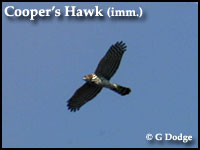
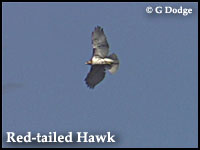
For the past few weeks, at least six of our local Blue Jays have been busily flying back and forth over Catch the Wind. They’ve been observed daily flying to large Willow Oaks well behind the Ornithopter, each with an acorn in its bill on the return trip, and probably several more stuffed in its throat. They’re burying, or caching, the nuts. Willow Oak acorns are small and, although I don’t know for sure how many acorns these Blue Jays can stuff into their gullets (perhaps 5 maximum), they’re likely carrying more than one at a time. I once watched a Blue Jay cram 16 sunflower seeds into its throat and one in its bill before flying off to cache the seeds.
I haven’t determined where they’re going with all of those acorns, where they’re burying them, but the cache must be quite large considering the amount of trips observed. Blue Jays will fly several miles to cache nuts. Many of the nuts cached by birds (and squirrels) are never relocated, leaving them to germinate and grow into trees. In effect, the birds (and squirrels) are planting trees. In a paper I read many years ago, one researcher theorized that Blue Jays played a significant role in the reforestation of eastern North America following the most recent period of glaciation. Some have suggested that squirrels were the real heroes of the reforestation story, but squirrels don’t carry acorns far from the mother tree before burying them, perhaps fifty yards if at all. While it’s true that acorns don’t fall far from the tree, Blue Jays will take them there (far from the tree, that is).
Picture the landscape 15,000 years ago when much of North America was under a thick sheet of ice at least as far south as Long Island, NY (Long Island is a terminal moraine). At that time the great eastern deciduous forest was much further south, hundreds of miles south of where it is today. Moving north from this ancient deciduous forest you would probably encounter boreal forest with spruces and other conifers (remnants of which can be seen today on the highest mountain peaks of western North Carolina), scrublands, perhaps steppe or vast dry grasslands, tundra and finally the glaciers themselves, a much different landscape then we see today. As the climate warmed and the glaciers slowly retreated northward at the end of the glacial period, those habitats or biotic zones moved north with them. But how did they move north, and so fast (10-12 thousand years is not a long time)? The trees couldn’t simply uproot and walk north.
As noted, most seeds or nuts that fall from trees, fall directly under the tree. Even the maples, ashes, and poplars with seeds that are carried by the wind and “helicopter” to earth don’t travel very far from the source tree. Left to their own devices deciduous trees would have taken perhaps hundreds of thousands of years to move north to their present locations. Squirrels would help somewhat by carrying off seeds and burying them at least some distance from where they fell to earth. And, as alluded to, it’s well documented that squirrels (or birds) that cache nuts don’t relocate many of the nuts (more than half, if I remember correctly), those nuts later growing into trees. Even with the squirrel’s help, this reforestation would still be a very slow creep north.
A bird that could carry nuts and seeds perhaps half a mile, 2, 5, or even 10 miles from where they originated, and of course, later forget where they were buried or simply just not have enough time to recover them all, would quicken the process considerably. There are many studies showing that Blue Jays will and do carry vast amounts of acorns and other nuts miles from where they were gathered, to be buried and subsequently forgotten, or in which the nuts buried germinated on their own before being used as food. And, the birds don’t put all of those nuts into one hole, but spread them out over the area so there could be many trees sprouting over a relatively wide area. In one study observers witnessed a group of jays move 133,000 acorns. In another, 150,000 acorns in just under a month’s time. That’s a lot of nuts! How many of those were never dug up and eventually grew into trees?
I saw the first-of-the-season Winter Wren and Golden-crowned Kinglet on the 18th of October. I consistently see Ruby-crowned Kinglets foraging with groups of warblers.
A Hermit Thrush was seen on the 29th and was the first one of the season. This bird, and perhaps a few others, will stake out a claim at the Museum near a good source of berries and stay the winter.
If you like sorting through hundreds of warblers, the 18th and 19th of the month was the day to be at the Wetlands. Magnolia Warbler, Black-throated Blue Warbler, Yellow-rumped (Myrtle) Warblers, and Palm Warbler, were all seen on those two days. Butter-Butts, or Yellow-rumped Warblers, arrived en masse on the 18th, making it difficult to sift through them all to pick out the other warblers in the bunch.
Yellow-rumped Warblers should be around for the duration, or at least until they’ve devoured all of the Wax Myrtle berries at the Museum (see Wax Myrtle, Explore the Wild Journal, September 1-15, 2008). While they do quite a bit of flycatching, these warblers can stay farther north than most of their fellow warblers, which for the most part, are strictly insectivorous and need to follow the season south. Besides feeding on the Wax Myrtle, you may catch a glimpse of a Yellow-rump at the bird feeders slurping suet along with one of the the local Pine Warblers.
Yellow-rumped Warblers are named for the yellow patch of feathers on their rump, just anterior of the tail (image above). Although much less colorful in their drab winter plumage, they also show a patch of yellow on each side of the breast. The yellow on the breast varies in brightness according to the age, sex and current plumage of the individual bird but there is usually al least some yellow present.
A few sparrows also showed up during the past few weeks. Chipping Sparrows arrived with the warblers on the 18th of October and a Field Sparrow was seen the following day. Several Song Sparrows were also observed. White-throated Sparrows have returned (see image), and should be with us until early May.
A male Rose-breasted Grosbeak flew in on the 18th and flocks of Red-winged Blackbirds were seen winging by overhead.
There are many young American Goldfinches about. For the past month they’ve been seen at the bird feeders and foraging among the ripening seeds, especially the Tick-seed, alongside the path in Catch the Wind. While the adult Goldfinches have molted into their drab winter plumage making them difficult to separate from the immature birds, the young finches can be differentiated by their buff, or tan-colored, wingbars.
